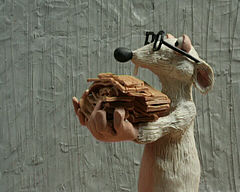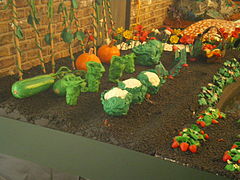| Revision as of 14:11, 21 February 2016 edit86.153.133.193 (talk) →Uses: spelling consistency.← Previous edit | Revision as of 19:56, 21 February 2016 edit undoAndy Dingley (talk | contribs)Autopatrolled, Extended confirmed users, Pending changes reviewers, Rollbackers160,399 edits →Uses: missed a bitNext edit → | ||
| Line 47: | Line 47: | ||
| Television presenter ] together with Chris Collins, ], Julian Fullalove and around 2000 members of the public created a show garden made entirely of Plasticine for the 2009 ]. Called 'Paradise in Plasticine', it took 6 weeks and 2.6 tons of Plasticine in 24 colours to complete. May said, "This is, to our knowledge, the largest and most complex model of this type ever created." It couldn't be considered as part of the standard judging criteria as it contained no real plants, but was awarded an honorary gold award made from Plasticine.<ref>{{cite news |title=RHS Chelsea Flower Show 2009: Paradise in Plasticine |url=http://www.bbc.co.uk/chelsea/small_gardens/may.shtml |agency=] |work=BBC One |accessdate=20 May 2009 }}</ref><ref>{{cite web |last=Elliott |first=Valerie |date=20 May 2009 |title=Top Gear plasticine garden takes 'gold' at RHS Chelsea Flower Show |url=http://property.timesonline.co.uk/tol/life_and_style/property/gardens/chelsea_flower_show/article6319449.ece |work=] |accessdate=20 May 2009 }}</ref> The garden was extremely popular with the public and went on to win the ] 'peoples choice' for best small garden.<ref></ref> | Television presenter ] together with Chris Collins, ], Julian Fullalove and around 2000 members of the public created a show garden made entirely of Plasticine for the 2009 ]. Called 'Paradise in Plasticine', it took 6 weeks and 2.6 tons of Plasticine in 24 colours to complete. May said, "This is, to our knowledge, the largest and most complex model of this type ever created." It couldn't be considered as part of the standard judging criteria as it contained no real plants, but was awarded an honorary gold award made from Plasticine.<ref>{{cite news |title=RHS Chelsea Flower Show 2009: Paradise in Plasticine |url=http://www.bbc.co.uk/chelsea/small_gardens/may.shtml |agency=] |work=BBC One |accessdate=20 May 2009 }}</ref><ref>{{cite web |last=Elliott |first=Valerie |date=20 May 2009 |title=Top Gear plasticine garden takes 'gold' at RHS Chelsea Flower Show |url=http://property.timesonline.co.uk/tol/life_and_style/property/gardens/chelsea_flower_show/article6319449.ece |work=] |accessdate=20 May 2009 }}</ref> The garden was extremely popular with the public and went on to win the ] 'peoples choice' for best small garden.<ref></ref> | ||
| In 1943, during World War II, Plasticine was used by ] as part of the defuzing<ref >{{harvp|Jappy|2001|page=rear cover}} "these bombs were to be defuzed 'regardless of the loss of life to bomb disposal personnel'."</ref> process for the new German type Y battery-powered bomb ]. It was used to build a dam around the head of the fuze, into which ] was poured to cool the battery down to a temperature at which it would no longer function, enabling the fuze to be safely removed.<ref>{{Cite book | In 1943, during World War II, Plasticine was used by ] Major John P. Hudson ] as part of the defuzing<ref >{{harvp|Jappy|2001|page=rear cover}} "these bombs were to be defuzed 'regardless of the loss of life to bomb disposal personnel'."</ref> process for the new German type Y battery-powered bomb ]. It was used to build a dam around the head of the fuze, into which ] was poured to cool the battery down to a temperature at which it would no longer function, enabling the fuze to be safely removed.<ref>{{Cite book | ||
| |last=Hogben |first=Major Arthur | |last=Hogben |first=Major Arthur | ||
| |year=1987 | |year=1987 | ||
Revision as of 19:56, 21 February 2016
Not to be confused with Pleistocene or Industrial plasticine.
| This article needs additional citations for verification. Please help improve this article by adding citations to reliable sources. Unsourced material may be challenged and removed. Find sources: "Plasticine" – news · newspapers · books · scholar · JSTOR (August 2010) (Learn how and when to remove this message) |
| Type | Modelling clay |
|---|---|
| Inventor(s) | William Harbutt |
| Company | Harbutt |
| Country | United Kingdom |
| Availability | 1900– |

Plasticine, a brand of modelling clay, is a putty-like modelling material made from calcium salts, petroleum jelly and aliphatic acids. The name is a registered trademark of Flair Leisure Products plc. Plasticine is used extensively for children's play, but also as a modelling medium for more formal or permanent structures. Because of its non-drying property, it is a popular choice of material for stop-motion animation (including several Oscar-winning films by Nick Park). The brand-name clay is mentioned in music, such as the "plasticine porters" in Lucy in the Sky with Diamonds and the song Plasticine by Placebo.
History
Plasticine was formulated by art teacher William Harbutt of Bathampton, in Bath, England, in 1897. He wanted a non-drying clay for his sculpture students. Although the exact composition is a secret, Plasticine is composed of calcium salts (principally calcium carbonate), petroleum jelly, and long-chain aliphatic acids (principally stearic acid). It is non-toxic, sterile, soft, and malleable, and does not dry on exposure to air (unlike superficially similar products such as Play-Doh, which is based on flour, salt and water). It cannot be hardened by firing; it melts when exposed to heat, and is flammable at much higher temperatures.
A patent was awarded in 1899, and in 1900 commercial production started at a factory in Bathampton. An improved formulation was patented in 1915. The original Plasticine was grey, but the product initially sold to the public came in four colours. It was soon available in a wide variety of bright colours. Plasticine was popular with children, was widely used in schools for teaching art, and has found a wide variety of other uses (for example moulding casts for plaster, and plastics). The Harbutt company promoted Plasticine as a children's toy by producing modelling kits in association with companies responsible for popular children's characters such as Noddy, the Mr. Men and Paddington Bear.
The original Plasticine factory was destroyed by fire in 1963 and replaced by a modern building. The Harbutt company continued to produce Plasticine in Bathampton until 1983, when production was moved to Thailand.
From 1983 to 2006, the brand went through a number of ownership changes and was off the market for a long time. Plasticine was owned by Bluebird Toys plc following its acquisition of Harbutt's parent company, Peter Pan. Then, following Bluebird's takeover by Mattel in 1998, the brand was sold on to Humbrol Ltd, famous for its model paints and owner of the Airfix model kit brand. In 2005, Flair Leisure licensed the brand from Humbrol and relaunched Plasticine. A year later, when Humbrol went into administration, Flair bought the Plasticine brand outright.
Similar products
A similar product, "Kunst-Modellierthon" (known as Plastilin), was invented by Franz Kolb of Munich, Germany in 1880. This product is still available, known as "Münchner Künstler Plastilin" (Munich artists' plasticine). In Italy, the product Pongo is also marketed as "plastilina" and shares the main attributes of Plasticine.
Uses

Plasticine and similar materials are often used in clay animation. One of its main proponents is Aardman Animations' Nick Park, who used characters modelled in Plasticine in his Oscar-winning Wallace and Gromit short films A Grand Day Out (1989), The Wrong Trousers (1993) and A Close Shave (1995), as well as the feature film The Curse of the Were-Rabbit (2005). This technique is popularly known as claymation in the US, and is a form of stop motion animation.
Plasticine-like materials are appealing to animators because the material can be used with ease: it is mouldable enough to create a character, flexible enough to allow that character to move in many ways, and dense enough to retain its shape easily when combined with a wire armature, and it does not melt under hot studio lighting.
Plasticine is used in long jump and triple jump competitions to help officials determine if the competitors are making legal jumps. A 10 cm wide 'indicator board' is placed beyond and slightly above the take-off line. The edges of this are chamfered and edged with plasticine If an athlete leaves a mark in the plasticine, it is considered proof that the jump was a foul, and the attempt is not measured. Plasticine is used rather than sand, so that several boards may be prepared in advance: if a board is marked it may be replaced by a smoothed board immediately to avoid delaying the competition, but keeping the marked board available in case of challenges. An indicator board is used, rather than a wide strip of plasticine, as this provides a firm footing should the athlete step on it.
Plasticine-like clays are also used in commercial party games such as Cranium, Rapidough and Barbarossa.
Television presenter James May together with Chris Collins, Jane McAdam Freud, Julian Fullalove and around 2000 members of the public created a show garden made entirely of Plasticine for the 2009 Chelsea Flower Show. Called 'Paradise in Plasticine', it took 6 weeks and 2.6 tons of Plasticine in 24 colours to complete. May said, "This is, to our knowledge, the largest and most complex model of this type ever created." It couldn't be considered as part of the standard judging criteria as it contained no real plants, but was awarded an honorary gold award made from Plasticine. The garden was extremely popular with the public and went on to win the Royal Horticultural Society’s 'peoples choice' for best small garden.
In 1943, during World War II, Plasticine was used by bomb disposal officer Major John P. Hudson R.E. as part of the defuzing process for the new German type Y battery-powered bomb fuze. It was used to build a dam around the head of the fuze, into which liquid oxygen was poured to cool the battery down to a temperature at which it would no longer function, enabling the fuze to be safely removed.
When an engine is being tuned for higher performance, different pistons and higher lift camshafts are often installed. This creates a risk that the valves might strike the piston, causing serious damage. To measure the valve-to-piston clearance, a piece of Plasticine can be put on top of a piston, the cylinder head replaced, and the engine rotated manually through a full cycle. When the cylinder head is removed, the valves will have made an impression in the Plasticine. The thickness of this impression is measured to give the valve to piston clearance.
See also
References
- espacenet citation of 1915 Harbutt patent
- International Association of Athletics Federations (IAAF). "Competition Rules 2016-2017, Rule 184.3" (PDF). pp. 208–210.
- "RHS Chelsea Flower Show 2009: Paradise in Plasticine". BBC One. BBC. Retrieved 20 May 2009.
- Elliott, Valerie (20 May 2009). "Top Gear plasticine garden takes 'gold' at RHS Chelsea Flower Show". The Times. Retrieved 20 May 2009.
- James May: Paradise in Plasticine
- Jappy (2001), p. rear cover "these bombs were to be defuzed 'regardless of the loss of life to bomb disposal personnel'."
- Hogben, Major Arthur (1987). Designed to Kill. London: Patrick Stephens Limited. pp. 131–133. ISBN 0-85059-865-6.
It was believed that by using liquid oxygen poured over the fuze head the necessary very low temperature within the fuze could be achieved.
- Jappy, M.J. (2001). Danger UXB. London: MacMillan Publishers. pp. 150–153. ISBN 0-752-21576-0.
That was wonderful when we got a bomb with the fuze lying at the top but if the fuze was at the side, it wasn't quite so easy. I think it must have been me who thought of the idea of making a little neck of clay around the side to hold the liquid. I think I used plasticine actually.
{{cite book}}: CS1 maint: ref duplicates default (link) - Car Craft: How To Check Valve-To-Piston Clearance